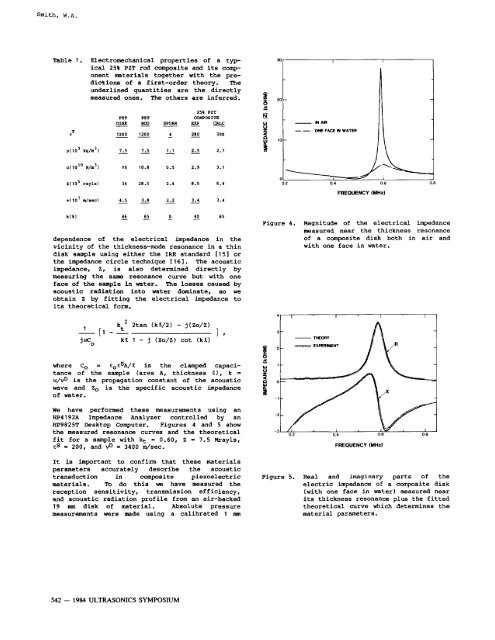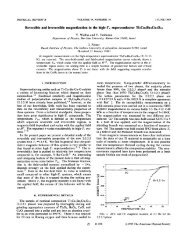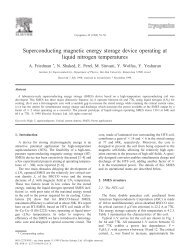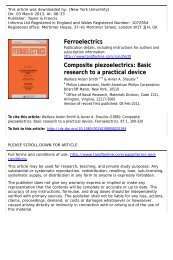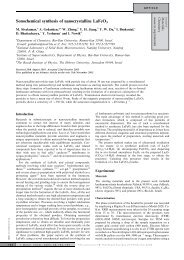Properties of Composite Piezoelectric Materials for Ultrasonic ...
Properties of Composite Piezoelectric Materials for Ultrasonic ...
Properties of Composite Piezoelectric Materials for Ultrasonic ...
You also want an ePaper? Increase the reach of your titles
YUMPU automatically turns print PDFs into web optimized ePapers that Google loves.
Smith, W.A.<br />
Table 1.<br />
Electromechanical properties <strong>of</strong> a typical<br />
250 PZT rod composite and its component<br />
materials together with the predictions<br />
<strong>of</strong> a first-order theory. The<br />
underlined quantities are the directly<br />
measured ones. The others are inferred.<br />
PZT<br />
DISK -<br />
-<br />
ET 1200<br />
PZT<br />
ROD<br />
-<br />
- 1200<br />
- SPURR<br />
- 4<br />
25% PZT<br />
COUPOSITB<br />
- E X P Z<br />
- 280 300<br />
- N A R<br />
OWE FACE N WATER<br />
pO03 k4/m3)<br />
__ 7.5<br />
- 7.5<br />
- 1.1<br />
- 2.5 2.1<br />
~ ( 1 N/m3) 0 ~ ~ 15<br />
10.8<br />
0.5<br />
2.9 3.1<br />
28.5<br />
2.4<br />
0.5 8.4<br />
02 0.4 0.6<br />
- 3.8<br />
- 2.2<br />
- 3.4 3.4<br />
FREQUENCY (MHr)<br />
- 65<br />
- 0<br />
- 60 65<br />
dependence <strong>of</strong> the electrical impedance in the<br />
vicinity <strong>of</strong> the thickness-mode resonance in a thin<br />
disk sample using either the IRE standard [15] or<br />
the impedance circle technique 1161. The acoustic<br />
impedance, Z, is also determined directly by<br />
measuring the same resonance curve but with one<br />
face <strong>of</strong> the sample in water. The losses caused by<br />
acoustic radiation into water dominate, so we<br />
obtain Z by fitting the electrical impedance to<br />
its theoretical <strong>for</strong>m,<br />
1<br />
kt2 2tan (kf/2) - j(Zo/Z)<br />
-[1-- 1 1<br />
kt 1<br />
WO - j (ZO/Z) Cot (kL)<br />
where CO = E ~ E ~ A is / ~ the clamped capacitance<br />
<strong>of</strong> the sample (area A, thickness E), k =<br />
w/vD is the propagation constant <strong>of</strong> the acoustic<br />
wave and Zo is the specific acoustic impedance<br />
<strong>of</strong> water.<br />
We have per<strong>for</strong>med these measurements using an<br />
HP4192A Impedance Analyzer controlled by an<br />
HP9825T Desktop Computer. Figures 4 and 5 show<br />
the measured resonance curves and the theoretical<br />
fit <strong>for</strong> a sample with kt = 0.60, Z = 7.5 Mrayls,<br />
ES = 200, and vD = 3400 nJsec.<br />
It is important to confirm that these materials<br />
parameters accurately describe the acoustic<br />
transduction in composite piezoelectric<br />
materials. To do this we have measured the<br />
reception sensitivity, transmission efficiency,<br />
and acoustic radiation pr<strong>of</strong>ile from an air-backed<br />
19 m disk <strong>of</strong> material. Absolute pressure<br />
measurements were made using a calibrated 1 mn<br />
Figure 4.<br />
P<br />
I<br />
- P<br />
Magnitude <strong>of</strong> the electrical impedance<br />
measured near the thickness resonance<br />
<strong>of</strong> a composite disk both in air and<br />
with one face in water.<br />
4 , I I I (<br />
- M O R Y<br />
02 0.4 0. E 0.8<br />
FREQUENCY (MHz)<br />
Figure 5. Real and imaginary parts <strong>of</strong> the<br />
electric impedance <strong>of</strong> a composite disk<br />
(with one face in water) measured near<br />
its thickness resonance plus the fitted<br />
theoretical curve which determines the<br />
mat er ial paramet er s.<br />
542 - 1984 ULTRASONICS SYMPOSIUM


